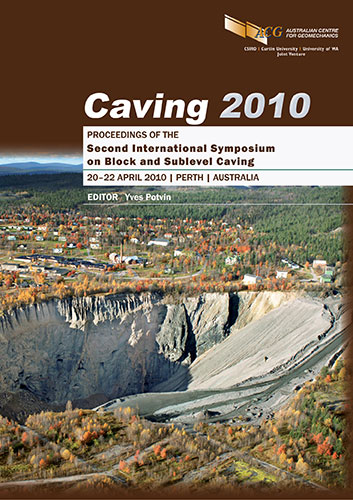Impact of poor fragmentation on cave management

|
Authors: Ngidi, SN; Pretorius, DD |
DOI https://doi.org/10.36487/ACG_rep/1002_41_Ngidi
Cite As:
Ngidi, SN & Pretorius, DD 2010, 'Impact of poor fragmentation on cave management', in Y Potvin (ed.), Caving 2010: Proceedings of the Second International Symposium on Block and Sublevel Caving, Australian Centre for Geomechanics, Perth, pp. 593-601, https://doi.org/10.36487/ACG_rep/1002_41_Ngidi
Abstract:
Palabora Mining Company operates a low grade underground copper mine situated in the Limpopo Province of South Africa about 560 km north east of Johannesburg. The mine is managed by the Rio Tinto Group and has been in operation since 1965. Full production underground was first reached in May 2005 after a successful transition from an open pit to a block cave mine. The cave is subdivided into four sectors comprising of 19 operational crosscuts. Caving was initiated in the weaker central sector, where the majority of discontinuities are located. This central sector is directly under the open pit bottom which is currently filled with over 150 million tonnes of waste material from the 2004 pit wall failure. The main constraint during the ramp up stage has been the poor fragmentation on the western side of the cave. The western section of the footprint, Sector 4, has the youngest drawpoints and the highest draw columns. About 36% of the ore reserves have to be extracted from Sector 4 which has a much coarser fragmentation compared to the rest of the cave. Estimation of practical production rates within acceptable limits had to be reviewed in order to enhance long-term production scheduling. Cave management and operational strategies had to be properly aligned with these challenges in order to achieve maximum ore reserve extraction.
References:
Laubscher, D.H. (1994) Cave mining - the state of the art, The Journal of the South African Institute of Mining and Metallurgy, Vol. 94, No. 10, pp. 279–293.
Moss, A., Russell, F. and Jones, C. (2004) Caving and fragmentation at Palabora: Prediction to Production, in Proceedings MassMin 2004, A. Karzulovic and M. Alvaro (eds), 22–25 August, Santiago, Chile, Instituto de Ingenieros de Chile, Santiago, pp. 585–590.
Diering, D., (2004) Combining long term scheduling and daily draw control for block cave mines, in Proceedings MassMin 2004, A. Karzulovic and M. Alvaro (eds), 22–25 August, Santiago, Chile, Instituto de Ingenieros de Chile, Santiago, pp. 486–490
Esterhuizen, G.S. (1994) A program to predict block cave fragmentation, Technical reference and users guide, Ver 2.1.
© Copyright 2025, Australian Centre for Geomechanics (ACG), The University of Western Australia. All rights reserved.
View copyright/legal information
Please direct any queries or error reports to repository-acg@uwa.edu.au
View copyright/legal information
Please direct any queries or error reports to repository-acg@uwa.edu.au